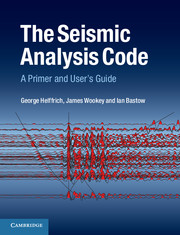Book contents
- Frontmatter
- Contents
- Preface
- Acknowledgements
- 1 Introduction
- 2 The SAC data format
- 3 The SAC processing philosophy
- 4 Basic SAC commands
- 5 SAC macros
- 6 Accessing SAC functionality and data from external programs
- 7 Graphical data annotation
- 8 Array data handling
- 9 Spectral estimation in SAC
- 10 Three-dimensional data in SAC
- 11 Implementation of common processing methodologies using SAC
- Appendix A Alphabetical list of SAC commands
- Appendix B Keyword in context for SAC command descriptions
- References
- Index
- Plate Section
1 - Introduction
Published online by Cambridge University Press: 05 October 2013
- Frontmatter
- Contents
- Preface
- Acknowledgements
- 1 Introduction
- 2 The SAC data format
- 3 The SAC processing philosophy
- 4 Basic SAC commands
- 5 SAC macros
- 6 Accessing SAC functionality and data from external programs
- 7 Graphical data annotation
- 8 Array data handling
- 9 Spectral estimation in SAC
- 10 Three-dimensional data in SAC
- 11 Implementation of common processing methodologies using SAC
- Appendix A Alphabetical list of SAC commands
- Appendix B Keyword in context for SAC command descriptions
- References
- Index
- Plate Section
Summary
WHAT IS SAC?
SAC is an acronym for the Seismic Analysis Code, a command line tool for basic operations on time series data, especially seismic data. SAC includes a graphical interface for viewing and picking waveforms. It defines a standard type of file for storing and retrieving time series and also reads files written in other data formats (SEG-Y, MSEED, GCF) used during field collection of seismic data. SAC is self-contained and does not rely on network access for any of its capabilities, including documentation, which makes it useful for field data quality control.
SAC reads data formats (CSS and GSE formats) used by nuclear test monitoring agencies. It also contains programming language constructs that provide basic methods for developing elaborate, multi-step analysis methodologies. Collectively, these features make SAC a useful interactive platform upon which customized analytical methods may be built and prototypical procedures may be developed.
SAC is widely known. The IRIS Data Management Center (DMC), one of the largest whole-Earth seismological data repositories in existence, allows data to be requested in SAC form. The instrument response information provided by the DMC's SEED reading program, rseed, is usable by SAC in pole-zero or evalresp form. Owing to SAC's longevity, a rather large and well debugged software tool ecosystem has evolved around its file format. One such tool, jweed, searches for and retrieves data held by the DMC. SAC data and SAC-compatible instrument response information are among its output options.
- Type
- Chapter
- Information
- The Seismic Analysis CodeA Primer and User's Guide, pp. 1 - 4Publisher: Cambridge University PressPrint publication year: 2013

